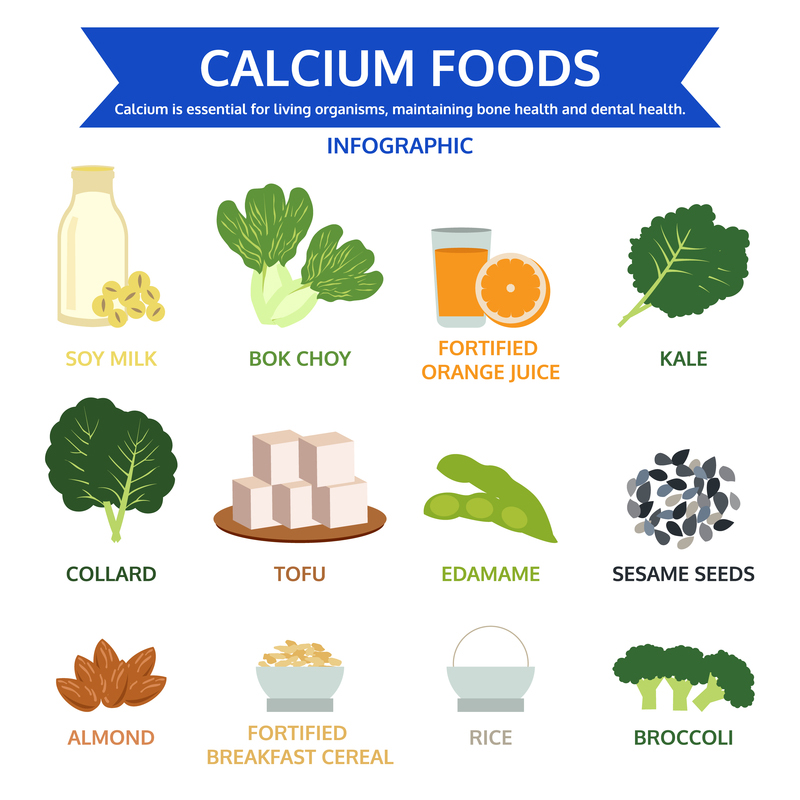Calcium-Rich Foods: Dairy and Non-Dairy Options, and How Much You Need Per Day
Getting your calcium intake from calcium-rich foods may be the most beneficial way to do it. You’ll find a surprising number of choices beyond dairy products.
In late 2016, Johns Hopkins Medicine released the results of a 10-year study that questioned the value of calcium supplement pills as sources of calcium. The findings prompted those with calcium deficiency symptoms to reach instead for calcium-rich foods. The study found that taking supplements as sources of calcium may cause more arterial plaque build-up and heart damage. The same study found that calcium-rich foods are protective to your cardiovascular system. Sounds good—who wouldn’t rather eat than pop a pill? And, you’ll be happy to know, there are a wealth of calcium-rich foods from which to choose.
Dairy, of course, initially comes to mind when you think about calcium-rich foods, and it doesn’t have to be full fat, either, so don’t worry about added calories or dietary fat. According to the National Institutes of Health, non-fat milk (299 mg calcium in 8 oz.), low-fat yogurt (415 mg in 8 oz.), and mozzarella cheese (333 mg in 1.5 oz.) are all good choices. While some sources claim dairy isn’t optimal as one of your calcium-rich foods because it has such a concentrated amount of calcium, most experts disagree. In fact, the USDA’s MyPlate nutritional system recommends that anyone over the age of 8 eat three cups of food from the milk group per day.
So, if you’re a dairy lover, you can easily ensure a healthy calcium diet and enjoy every bite. Since adults up to age 50 have a recommended daily allowance of 1,000 mg of calcium per day, it’s easy to get your minimum daily intake. (If you’re over 50, the recommendation is 1,200 mg per day.) Not a dairy fan? You have options, as we describe here.
View our calcium-rich food chart
Non-Dairy Calcium-Rich Sources
Many brands of orange juice are labeled “calcium-fortified” and will give you 261 mg of calcium in just a 6 oz. serving. Most cereals are calcium-fortified as well, and can add another 100 mgs or more, making cereal one of the best calcium-rich foods. The International Osteoporosis Foundation (IOF) says that almond milk—a product gaining popularity—has 90 mg of calcium in 200 ml, which is just over six ounces. An egg includes about 27 mg, and 120 grams of tuna (about 4 ounces) has 34 mg.
It’s a little tougher to find foods high in calcium in vegetables. The highest ones aren’t necessarily the most popular veggies. A half-cup of turnip greens will get you 99 mg, one cup of cooked kale is 94 mg, and a half-cup of fresh broccoli is 21 mg. Red beans will give you 93 mg in a little less than a cup (200 grams). Like green beans? Whole or French, green beans provide 50 mg of calcium in about a little more than a one-third cup serving.
Fruit lovers will appreciate that an orange has around 60 mg of calcium (around 6 mg). A quarter cup of dried figs has 96 mg, while a banana has around 12 mg, according to the IOF.
Pink salmon (181 mg/3 oz.), tofu (253 mg/4 oz.), and sardines (325 mg/3 oz.) all can add to your daily calcium intake. Red meat and chicken, on the other hand, aren’t such big sources of calcium. A 4-ounce serving provides 7 mg and 17 mg, respectively.
We’ve included a chart (below) from the National Institutes of Health on calcium-rich foods. You can also visit the IOF at www.iofbonehealth.org. And see our post “Alternative Sources of Calcium: 7 Reliable Food Types.”
| Food | Milligrams (mg) per serving | Percent DV |
|---|---|---|
| Plain yogurt, low fat, 8 oz | 415 | 42 |
| Mozzarella, part skim, 1.5 oz | 333 | 33 |
| Sardines, canned in oil, with bones, 3 oz | 325 | 33 |
| Fruit yogurt, low fat, 8 oz | 313-384 | 31-38 |
| Cheddar cheese, 1.5 oz | 307 | 31 |
| Milk, reduced-fat (2%), 8 oz | 299 | 30 |
| Milk, nonfat, 8 oz | 299 | 30 |
| Soymilk, calcium-fortified, 8 oz | 293 | 29 |
| Milk, buttermilk, lowfat, 8 oz | 284 | 28 |
| Milk, whole, 8 oz | 276 | 28 |
| Orange juice, calcium-fortified, 6 oz | 261 | 26 |
| Firm tofu, made with calcium sulfate, 1/2 cup | 253 | 25 |
| Salmon, pink, canned, solids with bone, 3 oz | 181 | 18 |
| Cottage cheese, 1% milk fat, 1 cup | 138 | 14 |
| Soft tofu, made with calcium sulfate, 1/2 cup | 138 | 14 |
| Ready-to-eat cereal, calcium-fortified, 1 cup | 100-1000 | 10-100 |
| Frozen yogurt, vanilla, soft serve, 1/2 cup | 103 | 10 |
| Turnip greens, fresh, boiled, 1/2 cup | 99 | 10 |
| Kale, fresh, cooked, 1 cup | 94 | 9 |
| Vanilla ice cream, 1/2 cup | 84 | 8 |
| Bok choy, raw, shredded, 1 cup | 74 | 7 |
| White bread, 1 slice | 73 | 7 |
| Chocolate pudding, ready to eat, 4 oz | 55 | 6 |
| Corn tortilla, one 6″ diameter | 46 | 5 |
| Flour tortilla, one 6″ diameter | 32 | 3 |
| Sour cream, reduced fat, cultured, 2 tbs | 31 | 3 |
| Whole wheat bread, 1 slice | 30 | 3 |
| Kale, raw, chopped, 1 cup | 24 | 2 |
| Broccoli, raw, 1/2 cup | 21 | 2 |
| Cream cheese, regular, 1 tbs | 14 | 1 |
Printable High Calcium Food Chart
Do I Need Calcium Every Day?
Most folks know that calcium contributes to healthy bones and teeth. But it’s also a key nutrient for normal cell functioning and an important messenger throughout the body. Calcium is active in nerve signals, hormones, blood clotting, and muscle contractions and relaxations.
Unfortunately, calcium intake can be tricky, because you may not notice when you’re low in calcium.
Any condition relating to the bones, nerves, teeth, kidneys, or heart could have a component of calcium deficiency. Your physician can order a blood test to check your calcium levels in light of any of these problems or if you show signs of osteoporosis or a thyroid disorder. Although it’s rare to see full-blown severe calcium deficiency, it isn’t something to take lightly, as it can result in death.
Symptoms of calcium deficiency may include chest pains, heart failure, seizures, and muscular weakness—not things that would make you immediately think, “I need to eat more ice cream.” (Vanilla has 84 mg in a half cup.).” These problems are also symptoms of more serious issues and should cause you to make a prompt doctor’s appointment.
You also may have odd feelings of fatigue, numbness, and tingling, dry and itchy skin, forgetfulness, or irritability—each of which could point to a calcium deficiency.
Factors Affecting Calcium Absorption
In order to function properly, calcium must be able to draw on the vitamin D and magnesium in our bodies. Without adequate levels of these nutrients, calcium will not be properly absorbed, which means no matter how much of it we consume, our bodies will not be able to use it properly.
The Vitamin D Council recommends we get 2000 IUs of vitamin D per day. Many doctors are on board with this level, although the Recommended Daily Allowance of vitamin D is still listed at 600 IUs per day. You need to discuss the amounts with your own physician. For magnesium, the Recommended Daily Allowance is 320 mg per day for adults.
RECOMMENDED FOR YOU
- “21 Calcium Deficiency Symptoms That Will Surprise You“
- “How to Get Calcium If You Don’t Eat Dairy“
- “22 Low Magnesium Symptoms: Do You Suffer from Muscle Spasms, Dizziness, Insomnia…?“
- “10 Vitamin D Deficiency Symptoms You Can Identify Yourself“
SOURCES



 Vegan Diet Better Than Omnivore Diet for Cardiovascular Health
Vegan Diet Better Than Omnivore Diet for Cardiovascular Health  10 Terrific Natural Diuretics
10 Terrific Natural Diuretics  Ask the EN Experts January 2024
Ask the EN Experts January 2024 
Calcium-rich foods include cheese, milk, and sour cream, nuts, fish, and spinach.